The Healthcare Businesswomen’s Association has one of the most influential networks in the industry. The organization has been successful in building powerful communities, including its Rising Star and Luminary honorees, as well as being a valued consultant to many of its corporate partners to guide the build-out of their internal women’s networks.
For more than 15 years, PharmaVOICE has been proud to support the HBA’s Rising Star and Luminary program and showcase more than 1,500 of the industry’s brightest and most talented leaders. And this year is no exception. These women have been recognized by their organizations for their contributions to the business, leadership as a role model, mentorship, dedication to the healthcare industry, and for being a true example of what top talent looks like.
In this special feature, we showcase all 117 Rising Stars and Luminaries, many of whom have identified their leadership style and what works for them. We also learn from these visionaries what they believe will be the most impactful trends 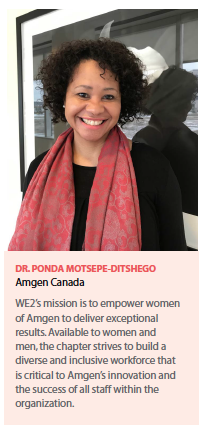 in the coming years. And new this year, this special feature kicks off with more than a dozen sponsored profiles of Rising Stars and Luminaries, who provide their inspirational leadership stories in their own words.
in the coming years. And new this year, this special feature kicks off with more than a dozen sponsored profiles of Rising Stars and Luminaries, who provide their inspirational leadership stories in their own words.
One of the unique advantages of being named a Rising Star or Luminary, is that these women now belong to an exclusive group. They have the opportunity to build their networks from among some of the most diverse and talented group of individuals in the life-sciences industry.
IWNs: A Win-Win
A recent study by researcher Shawn Achor reveals that women’s forums that strike a healthy mix of social connection, support, and motivation create lasting intellectual, professional, and financial results for female participants. In addition, a 2017 study showed 86% of female respondents believe participating in their corporate women’s employee resource groups, or ERGs, specifically benefitted them and their career. And 70% of those respondents said their women’s ERGs had actually helped to create policy changes at work.
A number of HBA corporate partners have very successful internal women’s network (IWN) programs in place, some are long-established and some are fairly recent. PharmaVOICE had a chance to connect with a few of these companies to learn about their best practices and programs.
 At Amgen, diversity matters. The company strongly believes in the importance of inclusion in the workplace to foster collaboration, innovation, and a positive culture. To create the best place for talent, Amgen Canada launched its chapter of Amgen’s global initiative Women Empowered to be Exceptional (WE2) on International Women’s Day in 2019. Ponda Motsepe-Ditshego, M.D., a 2019 HBA Rising Star heads up the chapter as its executive sponsor along with Dr. Francesco Di Marco, Amgen Canada’s VP and general manager.
At Amgen, diversity matters. The company strongly believes in the importance of inclusion in the workplace to foster collaboration, innovation, and a positive culture. To create the best place for talent, Amgen Canada launched its chapter of Amgen’s global initiative Women Empowered to be Exceptional (WE2) on International Women’s Day in 2019. Ponda Motsepe-Ditshego, M.D., a 2019 HBA Rising Star heads up the chapter as its executive sponsor along with Dr. Francesco Di Marco, Amgen Canada’s VP and general manager.
“WE2’s mission is to empower women of Amgen to deliver exceptional results," she says.
“Available to women and men, the chapter strives to build a diverse and inclusive workforce that is critical to Amgen’s innovation and the success of all staff within the organization."
As an unabashed champion of women and mother to a young girl, Ponda is a tireless advocate for creating a culture of inclusion and development for young girls and women and is heavily involved with STEM initiatives in her personal capacity as well as in her role at Amgen.
W2O, a privately held, healthcare-focused marketing communications firm, with 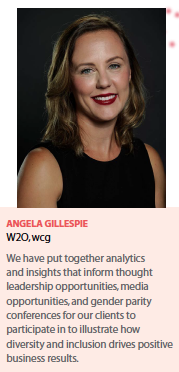 more than 700 people and 13 offices across the United States and Europe, recently launched its internal women’s network —Women of W2O — also known as WOW.
more than 700 people and 13 offices across the United States and Europe, recently launched its internal women’s network —Women of W2O — also known as WOW.
Casey Cole, group director, people experience, at W2O, says WOW is one of the first ERGs at the agency, and one that ensures that the culture is as inclusive as possible, as welcoming as possible, and as engaging and compelling as possible. “We believe strongly that making sure our culture is both inclusive and engaging helps drive retention and talent acquisition as well as helps us connect with our clients in a really smart, innovative, and interesting way," she says.
WOW kicked off earlier this year with its first event, an educational program that drew more than 150 employees in person and virtually from the agency’s various global offices.
WOW is an organic enterprise fostered by a group of six millennials to create an inclusive and innovative culture as well as one that supports W2O’s strategic goals.
As the sponsor of WOW Angela Gillespie, president, W2O wcg, guided the core team to ensure WOW’s core mission was based on education, tied to the agency’s overall mission, and was open to everyone in the agency.
“What I am so proud of is that this work isn’t being prescribed by leadership; it’s growing organically in the hallways and in the conference rooms and in the hearts of our people," Angela says. “And, for me, this is such an authentic way to build community and culture. At every meeting, we review WOW’s strategic goals and think about how we can support diversity and inclusion through our own talent acquisition and development programs and how we transfer that to our clients by developing best practices that can extend and connect our company to the industry at large."
To illustrate this point, the W2O team is providing strategic recommendations to elevate its female clients within their own organizations and within the industry. “We have put together analytics and insights that inform thought leadership opportunities, media opportunities, and gender parity conferences for our clients to participate in to illustrate how diversity and inclusion drives positive business results," Angela says. “We want our clients to be on the cutting-edge and have the best practices for diversity and inclusion, and we are ready to help them."
And W2O walks the walk and talks the talk. The agency has standout numbers when it comes to diversity: 67% of its workforce is female, 71% of females are in senior director roles or above, and 83% of the agency’s presidents are female. And this year, Andrea Johnston, president, W2O pure, has been named an HBA Luminary.
Both Angela and Casey credit Founder and CEO Jim Weiss for his vision, leadership, and creating a diverse and inclusive culture. He serves on the HBA’s global advisory board and made a commitment for W2O to join the HBA’s Gender Parity Collaborative.
Genentech, which is also part of the HBA Collaborative, has an internal women’s network that was established about a dozen years ago. The Genentech Women’s 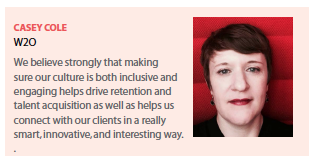 Professional group, or GWP for short, is one of about 20 affinity groups the company supports. With more than 2,000 members, the GWP is one of the company’s largest ERGs.
Professional group, or GWP for short, is one of about 20 affinity groups the company supports. With more than 2,000 members, the GWP is one of the company’s largest ERGs.
Carol Wells, senior director, commercial training and development, at Genentech says the company’s focus on developing its women leaders was driven from the top. “Years ago our CEO Ian Clark established a corporate goal of having 50% of women at the officer level, and the company was diligent in applying businesses strategies to achieve that goal," she says.
The reason for this focus was simple: women make up more than half of the Genentech workforce. While certainly not discounting the importance of other groups, the former CEO believed it was critical to start with his largest employee contingency. To achieve its goals, the company implemented a number of pipeline and development initiatives to drive to the goal, which was achieved.
In addition, Carol says the company holds a leadership summit, which just celebrated its 10th anniversary, every year for its top female leaders, and every year it sells out.
Carol, who is an HBA STAR honoree and advocate for the association, notes there is a synergistic relationship between the GWP and the HBA through which Genentech women can have the opportunity to network, be mentored, and develop additional skills with people outside of the organization, which is hugely beneficial.
This year, Genentech recognized Jennifer Foley, global head, business insights and analytics (BIA), product development clinical operations and Saileta Prabhu, Ph.D., senior director, development sciences, as its Rising Stars. Roche, under which Genentech operates as a wholly owned subsidiary, recognized two of its top female leaders as HBA Luminaries: Cristin Hubbard, lifecycle leader, Hemlibra, and Sheri Morin, chief purpose officer. To learn more about these four outstanding talents as well as nine of their Rising Star and Luminary peers from BD, Inovalon, IQVIA, Mallinckrodt Pharmaceuticals, Microsoft, Takeda, and Tesaro please turn to the featured profiles within this special section.
Recognizing Excellence
The HBA’s core purpose is to further the advancement and impact of women in the business of healthcare, and its mission is to achieve gender parity in leadership positions, facilitate career and business connections, and provide effective practices that enable organizations to realize the full potential of their female talent.
In addition to its Woman of the Year award recogition program, since 2007 the association has recognized exemplary leadership initiatives that advance and enhance the careers of women through its ACE (Advancement, Commitment, Engagement) award.
In 2019, the HBA ACE Award will recognize internal initiatives that are: accelerating innovation; driving measurable business results and outcomes; and increasing in reach, scale, and exposure. The organization welcomes applications from public and private companies of all sizes and companies are not required to be HBA corporate partners to apply. Up to three winners will be selected and recognized at the 2019 HBA annual conference in San Diego in November. (For more information, please visit hbanet.org.)
In 2018, the HBA recognized Pfizer, Insigniam, and KPMG as ACE winners for their exemplary workplace initiatives that are helping to advance women and drive gender parity in the business of healthcare. The 2018 honorees joined an elite group of organizations that are committed to realizing the full potential of their female talent pool by fostering programs that deliver impactful and measurable results.
At the award ceremony last November, Laurie Cooke, HBA president and CEO, said given that women comprise 85% of all customer healthcare decisions, organizations such as Pfizer, Insigniam, and KPMG have demonstrated how to effectively leverage their internal initiatives to advance gender parity and just as importantly to deliver strategic business insight.
Pfizer was recognized for demonstrating an extraordinary drive to unlock the full potential of its female talent pool with a portfolio of game-changing programs offered through its internal global women’s network.
KPMG was selected for championing innovative and strategic research that enabled data collection of employee insights around the world to enhance its leadership programs. KPMG used crowdsourcing to identify and understand diversity and inclusion challenges and opportunities to develop relevant, targeted, and measurable solutions.
Insigniam was recognized for fostering a culture of meritocracy that has resulted in achieving gender parity in leadership with its women leaders representing 60% of the company’s partners and 55% of its consultants. Insigniam has successfully integrated the HBA’s programs as a core component of its company’s employee leadership development and is a model for how small businesses can leverage these programs to develop their women leaders and drive business goals.(PV)
~~~~~~~~~~~~~~~~~~~~~~~~~
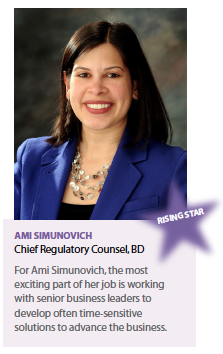 Ami Simunovich
Ami Simunovich
Advancing Equality and the Business
Oftentimes, the legal side of a business is viewed as just functional support for mitigating risk. So, for Ami Simunovich, chief regulatory counsel at BD, her recognition as an HBA Rising Star demonstrates that she and her team are valued for the key role they play in advancing technology in healthcare and that her voice is being heard in the decision-making process.
Ami says the most exciting part of her job is working with leaders to develop time-sensitive solutions to advance the business. And she combines a unique set of skills in that role as both a scientist and a lawyer — an invaluable combination as she helps the company navigate complex and changing global regulations.
A role model to her colleagues, Ami is active in BD’s global women’s network, WIN, and works to assist anyone interested in career development planning. “I try to help others navigate obstacles, such as how to access mentors or sponsors within the organization, and how to position themselves for key roles," she says.
Having good mentors and sponsors has helped Ami in her career and she wants to pay that forward.
“I’ve been able to accelerate my career because people saw my leadership potential and how my unique educational and professional background, judgment, and communication skills positioned me well for certain roles," she says.
Ami has been at the forefront of advocating for women in the industry for some time. She founded the Women’s Network at CR Bard, which BD acquired in 2018, advocating to senior management the value that such a network brings to women and the business. Ami is now the global team lead for WIN, working to maximize BD’s sponsorship with the HBA and seeking greater involvement in dedicated societies to attract more women engineers and scientists to the company.
“This year, we’re focused on getting the word out about a better balance of women in the workplace and how to best use a network for career development," she says.(PV)
~~~~~~~~~~~~~~~~~~~~~~~~~
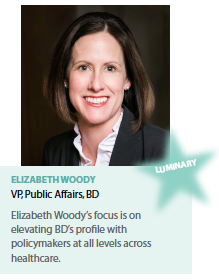 Elizabeth Woody
Elizabeth Woody
A Dealer in Hope
Elizabeth Woody and her colleagues in public affairs are making a significant and meaningful difference to BD. The fact that her contribution has been acknowledged by the company earning her recognition as an HBA Luminary is, she says, is a reflection of the strategic value that the organization finds in the capabilities of her team..
As VP of public affairs at BD, Elizabeth works to elevate BD’s relationship with policymakers — legislators, administration officials, professional organizations, patient groups, actually any entity that is setting policy. She says through these relationships, the team gains insights into the market and stakeholder priorities, which allows them to bring these understandings back into the business.
Public affairs at BD is focused on helping to shape policies that affect corporate operations, guide public health policies around such topics as antimicrobial resistance and opioid addiction, and enable market access for BD’s products.
“What excites me about my job is being part of critical policy conversations and elevating awareness of the company’s ability to address public health needs," she says.
She leads her team as a “dealer in hope," recognizing that it’s her job as a leader to focus her team on finding solutions to the challenges that the company faces.
“It’s about a spirit of optimism and being creative about finding a path forward to solve problems," she says.
Elizabeth has been part of the formal mentor and sponsor programs at BD. But it’s the informal relationships that resonate. She enjoys helping people to think through their work activities, as well as how they can grow their careers, opportunities, and experiences.
In an organization the size of BD, Elizabeth believes it’s important that those mentoring relationships extend outside one’s own function to garner ideas on how to grow one’s career in different ways.
Her advice to women starting out or mid-way through their career is to try a bit of everything and not get too focused on one area. The more experiences you have, she says, the broader your perspective.
“What attracted me to BD 10 years ago, was the fact that our products are so fundamental to the delivery of healthcare that there’s hardly an issue that we don’t care about or can’t help address," Elizabeth says. (PV)
~~~~~~~~~~~~~~~~~~~~~~~~~
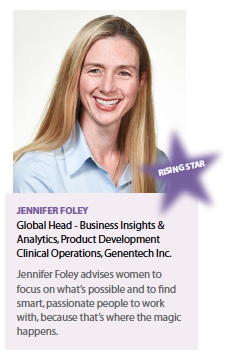 Jennifer Foley
Jennifer Foley
Bringing the Right People Together
Being named an HBA Rising Star by her company Genentech is one of those “wow" moments for Jennifer Foley, who says she is energized to inspire others.
As a servant leader, Jennifer is focused on helping others succeed. She looks to hire smart, curious people with a diverse set of skills and experiences. “If I can enable others to succeed in some small way, then that’s a good life’s work," Jennifer says.
“I’m always on the look out for those individuals who have the mindset to succeed or fail with their colleagues for the greater good," she says. “I love to hire smart people, incredibly capable of course, who are curious, and most importantly, I like people who want to play for the name on the front of a jersey and not the back. My role as a leader is to find the right talent and foster an environment where people can bring their full self to work and be comfortable experimenting, succeeding, failing, and learning together.
Jennifer joined Genentech in 2005 as an intern, and recently moved from the U.S. commercial organization to head up a new function within global clinical operations as global head, business insights and analytics, product development. She is focused on late-stage trials. Her team’s challenge is to embed and enhance insights and analytics to accelerate the delivery of these trials to get medicines to patients faster. “We’re in such an interesting space today with the availability of big data and insights that enable us to make better decisions for our trials," Jennifer says. “Some of this entails identifying patient populations and picking the right trial sites. It’s also about bringing consistency and discipline to how we forecast and track the performance of our studies, clinical programs, and the portfolio and make adjustments as needed. The benefit that we can provide for patients and for mankind is astronomical."(PV)
~~~~~~~~~~~~~~~~~~~~~~~~~
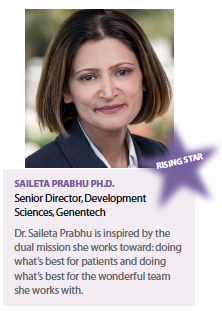 Saileta Prabhu, Ph.D.
Saileta Prabhu, Ph.D.
Translating Molecules into Medicines
Taking a people approach to leadership, Saileta Prabhu, Ph.D., is always looking for what’s the next best thing for the organization, her team, and patients. As senior director of development sciences at Genentech, she has a commitment to meeting the company’s objective — to deliver new medicines to patients.
“My focus on science and patients is my North Star; it’s entrenched in who I am and guides where the people I lead need to go," she says. Saileta’s role is to help research design the right molecules and start preparing them for clinical trials and then to translate what was learned in the research and preclinical phase for the clinical phase. “I am always thinking about how we can push ourselves," she says. “And once we are there, how can we even push further? What’s the next thing on the horizon?"
Her passion for patients began early for Saileta, who grew up in India where 90% of people live in poverty, and she was driven to do something for them. She went to pharmacy school, then got her Ph.D., and has been working at Genentech for 15 years now.
There have been many important mentors in Saileta’s career, who have helped her focus on truly being there for other people. One piece of advice that resonated with Saileta came from a former HBA Rising Star, Dr. Rhona O’Leary, who said: Saileta, from today onwards, you’re not going to think about ‘I.’ You’re going to think about what you did today to put something on someone else’s résumé that made them feel happy and proud. This piece of advice has been so helpful to me, Saileta says.
Saileta is grateful to a culture at Genentech that embraces diversity and inclusion and is supportive of women, noting such HBA honorees as Dr. Sue Desmond-Hellmann and Jennifer Cook as Women of the Year and Ian Clarke as Mentor of the Year. Her long-time manager and mentor at Genentech, Dr. Paul Fielder, is her inspiration, having seen him drive major efforts for minorities, under-privileged students, and female leaders.
Her advice to women is to build your network and relationships with people and push yourself to be the fiercest you can be.
~~~~~~~~~~~~~~~~~~~~~~~~~
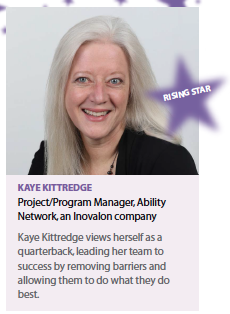 Kaye Kittredge
Kaye Kittredge
A True Servant Leader
Kaye Kittredge is a true servant leader. The most fulfilling aspect of her job as a project manager at Inovalon is the sense of accomplishment she enjoys by removing barriers for people and allowing them to do what they do best.
Kaye works in the operational excellence group for Ability Network, an Inovalon company. She joined when the company was broadening its offerings to include more clinical results analysis. She began with helping the go-to-market teams consistently roll out products, then moved to a more strategic role to drive greater operational improvements and integration.
A career transformation for Kaye came when she transitioned from being an executive assistant to being an individual contributor with her own projects to run, her own initiatives to complete, and helping to facilitate programs such as quality improvement and diversity awareness. “The skills involved naturally translated from helping executives get through their day to helping teams come together and to leverage the specialties they all bring to achieve something greater," she says.
When she first learned she had been recognized to represent Inovalon as an HBA Rising Star, she was stunned.
“A lot of what I do is behind the scenes," she says. “I am lucky to work with this excellent group of people, so to receive this recognition is truly an honor. Being part of an organization that connects different sources of information to improve overall healthcare is really meaningful work."
Drawing on her own experience, the biggest piece of advice Kaye has for women who are mid-career is don’t be afraid to take time out. Indeed, she did just this to look after her children and her aging parents and in-laws.
“It used to be that if you had gaps in your résumé, you didn’t know how you would explain it when you got back into the workforce," she says. “But people have different things going on in their lives and your experience is embraced when you find the right place."(PV)
~~~~~~~~~~~~~~~~~~~~~~~~~
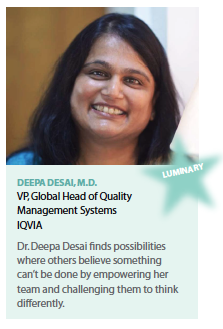 Deepa Desai, M.D.
Deepa Desai, M.D.
Putting People at the Center
In her role as VP, global head of quality management systems at IQVIA, Deepa Desai, M.D., brings a mix of transformational and democratic leadership to the table.
“I believe in being transformational and want to be known as a leader to whom colleagues come to, when they want positive disruption or a complete change of approach/thought" Deepa says. “I always try to see the possibilities, change the way we do things, do things differently.
““I also challenge people to think differently and I encourage my team to challenge me to think innovatively," she continues. “I believe a problem never exists without a solution and thus I empower my team to bring new ideas forward to see how we can overcome problems. I also believe that as a team leader I need to take ownership for whatever the outcome of that approach is."
A true team leader, Deepa always stands up for and by her team, believing in the motto “All for one and one for all."
Creating Order Out of Transformation
A physician with a homoeopathy qualification by education, Deepa joined the cardiac safety services (CSS) department of what was then Quintiles. Under her leadership, CSS developed a first-in-kind capability to provide 24/7 centralized monitoring of electrocardiograms for global clinical research studies. Within three years, the organization grew from 10 to more than 60 medical professionals and became the first ISO-certified global remote cardiac monitoring organization and set a new global standard.
“This was back in 2002, and it was the first time I understood the meaning of the world being flat because we were working 24/7 and supporting physicians and clinical trial subjects across the world," she says.
After a decade transforming that business, Deepa moved into the clinical delivery network, overseeing close to 3,800 employees worldwide. Today, she manages a relatively smaller but highly impactful team of global professionals handling quality and compliance systems, which boasts of having 70% women team members.
Managing people in different time zones is not a new experience for Deepa, and while at first there were some challenges to work out in terms of process, time zones, etc., she found that technology has helped to bridge many gaps e.g. by having recorded daily video calls, ease of data and personnel access, etc. thus enabling her and her team to succeed in the global aspect of the work they are doing.
“Having a team located around the world encourages us to think globally," she says. “It exposes us to different ways or approaches, opens up new opportunities, and encourages innovative thinking," she says. “At the end of the day, although we may come from different cultures and have different ideas, the emotional intelligence of people is the same wherever we come from."
Working for IQVIA, Deepa has been involved with many innovative developments. When IMS Health and Quintiles merged to become IQVIA, the team in India recognized that while this brought opportunities, employees had many questions regarding the benefit of the merger.
“There were a series of various events organized for employees to celebrate the merger, interact with each other, understand and appreciate the value of each other’s businesses while recognizing the combined strength of both," she says. “We organized activities using various platforms, including townhalls, an exhibition, a Hackathon, etc. which helped create a great impact."
The Heart of a Physician
One of the best aspects of the job for Deepa is helping patients live better lives. That passion for bringing happiness to people is intricately woven into the fact that Deepa is at heart and soul a physician. Another aspect of her role that she loves is creating possibilities for her colleagues.
“One of the best moments for me is when someone recognizes his or her own potential and sees the possibilities" she says. “I believe that as a leader it’s my responsibility to create more leaders, not only for IQVIA but for the industry and society."
Deepa is sought out as a mentor throughout IQVIA and works closely with emerging female leaders, since this is her passion.
Deepa notes there are several key trends within clinical development, including capabilities enabled by artificial intelligence and machine learning. But important as these are, they don’t replace the human touch.
“Technology today means I can order anything from my phone — medicines, food, travel, etc." she says. “Technology can take us anywhere. But only another human being can provide the compassion people need, only another person can be there to truly listen to someone and help them deal with discomfort or sadness. The unique quality that human beings bring will never be replaced."
She believes it is important for every man and woman to pursue interests and passions outside of work. “It’s all about the choices you make," Deepa says. “If you can have the same respect and dedication for your personal interests and goals as you have for timelines at work, you can make them happen."
Her advice for other women professionals is to take risks and dare to be happy. “Change can be scary," she says. “But if you take on a role with passion, the possibilities are endless."
Being named an HBA Luminary is, she says, both an honor and very humbling, but also shows her that the contributions she and her team in India make are valued. (PV)
~~~~~~~~~~~~~~~~~~~~~~~~~
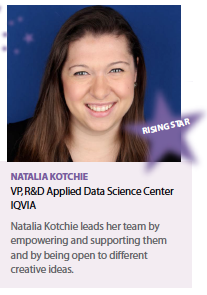 Natalia Kotchie
Natalia Kotchie
Connecting the Dots
Although Natalia Kotchie has predominately spent her whole career with one organization, it’s been full of variety. Since starting her career with what was then IMS Health, Natalia has worked in many different functions, with a wide variety of teams, and in myriad different locations.
Natalia started out with IMS in New York, spent a year in London, worked out of the San Francisco office for a while, and four years ago returned to London.
“I always wanted to study or work abroad and being given the opportunity early in my career to travel enabled me to learn from teams operating in different cultures and different healthcare environments," she says. “Having lived in different countries and experienced different systems helps me appreciate the environment, opportunities, and challenges each region has."
Today as VP, R&D Applied Data Science Center, IQVIA, Natalia focuses her team on how data science, analytics, and technology can be used to transform clinical development. When IMS merged with Quintiles to become IQVIA, Natalia started up an analytics team dedicated to R&D, initially with four people. This group has grown to nearly 200 people working across different geographies. The teams are comprised of data scientists, solutions experts, software engineers, product managers, operational deployment, and go-to-market teams.
“When I started the team, we identified the specific problems that we wanted to solve, and focused on addressing those, which allowed us to align the entire team," Natalia says. “This was important as we were building this team from the ground up and continuously bringing new individuals onboard over a two-year period."
The team’s objective is to help the clinical trials industry address its many challenges — from protocol amendments to underperforming sites to patient recruitment difficulties. The first step was to understand the needs and then identify the capabilities IQVIA could use to address the goals.
“We asked ourselves what kind of organization we needed, how did it need to function, and how should it interact with the broader business?" Natalia notes.
“With the merger, we saw the promise of data, machine learning, and AI to solve many of our challenges," she continues. “But it’s important to recognize that great data, analytics, and technology must be deployed effectively within the trial, with many different functions and individuals involved. So, it’s important to work closely with all of the stakeholders who will be using these capabilities because we’ll only see a positive impact if we make the solutions work for them."
Creative Problem Solving
Working with a team of people who are passionate about innovating to improve how clinical trials are done in order to help customers bring drugs to patients sooner is what makes the job so enjoyable for Natalia.
“The best part of my day is seeing the creative ideas that the teams come up with to solve problems in new and different ways," she says. “It’s the creativity, ability to problem solve, new idea generation, and innovative spark that really excite me."
Natalia sees her role as a leader being in part to identify talented individuals and empower them to do their job, while still providing the support they need. “I want the team to have a good debate and bring different perspectives to the table," she says. “This is particularly important as we are always looking to do something new. If everyone has the same idea, we won’t necessarily be able to generate the innovation or challenge each other to come up with a better solution. I look for team members who are able to challenge each other so that we can further our mission." With many different skill sets and functional backgrounds within her team, Natalia says one of her biggest leadership abilities is to connect the dots of what the team of experts needs to do to build out the innovative solutions being pursued and provide the needed support for her teams to achieve their personal and professional goals.
Mentoring is ingrained in the IQVIA culture, both formally and informally. Currently, Natalia has several formal mentees and says she loves being a mentor. She has formed a strong relationship with her mentees and says she has learned a lot from them while also supporting them in the areas they are seeking to develop.
“These are very bidirectional relationships; I benefit just as much from the mentoring experience and supporting others," she says. “And being in such a big company, the fact that I’m mentoring individuals from the operations side of the business gives me exposure to people who I wouldn’t have met had it not been for IQVIA’s mentoring framework."
Her advice to women starting out is to listen and to be open to new ideas.
“Healthcare is evolving, and we’ll see a lot of positive change over the next couple of years, so there’s much to be learned from different people," she says.
As for her being named as an HBA Rising Star for IQVIA, Natalia describes it as a tremendous honor, not least because of the depth of strong and talented women in the organization. (PV)
~~~~~~~~~~~~~~~~~~~~~~~~~
Melissa Falcone
A Positive Focus on the Future
Melissa Falcone believes in looking to the future — for her team, her company, and the patients Mallinckrodt serves. In the seven years she has been at the company, she has seen a huge transformation in its patient engagement model.
As VP of patient services and reimbursement, Melissa was given full autonomy to deliver on the goal of adding value to patients with high unmet needs.
“My team and I have a mindset of continuous improvement," she says. “We’re always thinking about what more can we do to positively impact patients, their experience with our company, and innovative ways we can continue to raise the bar of our service to them."
A believer in a shared vision for the future, Melissa works to create alignment around that vision and then empowers her team to do what they do best. It’s this commitment to transformation that led to her honor as an HBA Rising Star.
The future of healthcare, she believes, lies in the intersection of technology with patient-centricity. “Mobile apps, telemedicine, and wearables impact our ability to help patients manage their disease and also provide a huge amount of data that can be analyzed through AI to help us further advance our knowledge of disease areas and evolve our products to serve patients’ unmet needs," she says. “I see my team’s function as a very important one within the company, and I think that we are the nexus point for patient-centricity and taking care of people to get them to a better outcome with their healthcare."
Over her 18-year career, Melissa credits the mentors she has had along the way who encouraged her to take risks. In turn, she seeks to mentor those who are motivated and passionate about what they do or who simply may need help to build their confidence.
Her focus on creating opportunity is well reflected in her choice of office decorations: a tiny ceramic dragon, given to her by a former boss, represents opportunity. “I keep the dragon as a symbol to remind me to stay focused on the future for myself, my team, my company, and patients," she says. “I feel very empowered here. I believe the sky is the limit in terms of what my team’s contribution to our patient population can be."(PV)
~~~~~~~~~~~~~~~~~~~~~~~~~
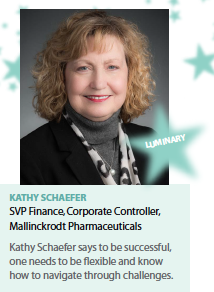 Kathy Schaefer
Kathy Schaefer
Leading Through Change
Twenty-five years may seem like a long time to be with an organization, but when it’s one that has been through many transformations, there’s no chance of becoming complacent. As senior VP finance, corporate controller, for Mallinckrodt, Kathy Schaefer has guided her team through many changes, which keeps her people highly motivated. She stays focused on setting the course and building the company’s values and reputation amid acquisitions, spin-offs, and other changes that affect the business.
“We have to be flexible as we navigate through various challenges," Kathy says. “Because of all the different transactions and variety of work my team has been doing, they are gaining a great deal of experience."
Kathy leads by enabling her reports to do their own thing, providing ongoing two-way communications, and giving her reports what they each need when they need it. “Some people need more guidance, some need less," she says. “You have to get to know your people, and then understand what their needs are. I have an excellent staff who do a good job and who are eager to make work more enjoyable for our extended team."
Within her team, she takes a people-focused approach to work-life balance by creating a fun, collaborative atmosphere. She encourages an open environment where people work in their own areas as well as across cross-functional projects.
Kathy has been a formal mentor within the company in the past, but today she guides people informally both within her direct group and beyond. She advises people to demonstrate their value to the company by doing a good job, after which their voice will be taken more seriously, and to step up and get involved, e.g., address a resource shortfall, participate on a cross-functional project, or serve on an inclusion and diversity team. She is active in HBA as well as with the company’s Women in Business ERG, and she serves as Mallinckrodt’s representative for Women in Business for the St. Louis area. (PV)
~~~~~~~~~~~~~~~~~~~~~~~~~
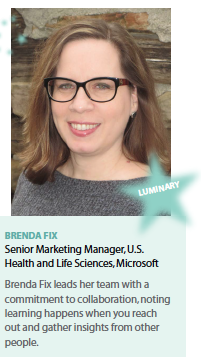 Brenda Fix
Brenda Fix
Collaboration and Communication: Keys to Good Marketing
There are two words that sum up Brenda Fix’s leadership style: communication and collaboration. This is because of her personality and the nature of her role as senior marketing manager, US health and life sciences, at Microsoft, where she works with people from different parts of the business who have different goals and different ways of thinking. “I’ve spent my career managing teams and projects with diverse internal and external stakeholders," she says. “Working with V-teams, or virtual teams, I run projects with C-suite, marketing, development, partner, and customer team members. These individuals think differently, so it’s important as marketers to to listen to their project goals and learn what their business problems are."
Brenda notes that while the IT industry in general falls short of hiring women at the same rate as men, she is seeing more high-quality, talented, and diverse women joining the marketing organization.
“I focus on the positive, that we have talented women on staff. I mentor and develop them, alert them to opportunities, and educate them on other disciplines in the company," she says. “We want women to understand and develop their strengths and see how far they can go with their careers."
Brenda says she loves getting to meet different people from within Microsoft and her customers, and learning about their breakthrough projects. For example, while working with Takeda (a customer) and a colleague, she learned about the Global Commission to End the Diagnostic Odyssey for Children (the Global Commission). Takeda, Microsoft, and EURORDIS-Rare Diseases Europe are co-chairs of this alliance of more than 800 rare disease patient organizations.
“We’re using our tech platform to help clinicians find the needle in a haystack when diagnosing rare disease," she says. “One of my colleagues in Spain developed a cloud-based AI and machine learning tool that analyzes patients’ genetic material and offers clinicians a list of possible rare diseases to help speed diagnosis."
In February, the Commission put forward its recommendations that map to three solution pathways: empowering patients and families, equipping frontline providers, and empowering patients and families. There are more than 6,000 identified rare diseases, the vast majority of which begin in childhood, with patients receiving a misdiagnosis more than once in 40% of cases. Brenda believes AI, when used securely and ethically with unbiased data, can help customers find ways to solve their biggest business and clinical challenges.
“Meeting customers and learning how they use our tools to improve the lives of patients is the best part of my job," she says. “I always learn something new when I talk with customers, and collegues. We have a great network of people and they contribute not just to what I’m doing, but to the overall project. Collaborating is a great way to learn and make new connections."
Charting a Path to the Top
Brenda has a vast knowledge of healthcare IT. She joined Microsoft five-plus years ago, after a fulfilling career at Quest Diagnostics and Siemens Healthcare. She enjoys start-up projects and working in an entrepreneurial mode. She started her health IT marketing career by joining CareScience, an Internet-based, risk-adjusted outcomes tool in the mid-1990s.
“I’ve been watching healthcare IT for a long time, and while there are women in the field, and more coming in, there is still a lot of work to be done to get them a seat at the table." Her advice for women entering the workforce is to talk to people and ask lots of questions ,because most people want to help others gain new insights or knowledge.
At the mid-career point, Brenda says women should be open and willing to take new paths from where they started. This may be a senior role or it might a position in another area of the company. The bottom-line she says is to be open to opportunity.
“Remember that you define your success," she says. “Climbing the ladder to management or the C-suite is just one path. Mid-career women have a lot of tribal knowledge and experience. They don’t have to be a manager, director, or executive to have a rewarding career. They need to be recognized for the value they bring to the organization."
Brenda knows first-hand that a fulfilling career doesn’t always follow a straight line from point A to point B.
“I’ve been in healthcare for 30 years," Brenda says. “I started out as an English writing major, working at Pittsburgh Magazine. I then went into medical publishing. I never would have guessed that I would be leading health marketing at Microsoft. My advice is to follow your interests and don’t be so wed to what you or others think you should be doing, because you may find something that’s even more interesting."
Brenda recognizes that work-life balance for women is tricky and having been a working mom with two daughters, now 20 and 25, she knows the pros and cons of trying to do it all and still be a role model to her children. She also notes that her husband has always supported her career. “I want my kids to know they can have a good career and be a parent and they don’t need to be a CEO to be successful." (PV)
~~~~~~~~~~~~~~~~~~~~~~~~~
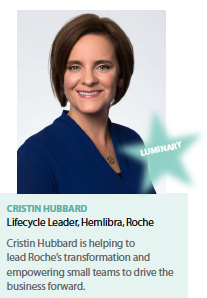 Cristin Hubbard
Cristin Hubbard
Working Toward Healthcare Advances
Growing up as the youngest daughter of a nurse, the desire to help patients was strong for Cristin Hubbard. She considered being a doctor but was drawn to drug discovery as a medicinal chemist and later pursued public health and the business side of drug development and commercialization, all of which encompass a 20-year career in healthcare.
“I wanted to be more closely involved in getting medicines to patients," she says of her career path.
Today, as lifecycle leader for Hemlibra, Roche’s breakthrough treatment for hemophilia A, this is precisely what Cristin is doing, acting as the de facto CEO of the molecule.
“It’s been rewarding to take this transformational medicine that can benefit patients to market by not only building the trust that is important for the hemophilia community, but also thinking uniquely about how to get Hemlibra to patients in all parts of the world," she says.
Cristin leads her team with a focus on authenticity, transparency, courage in decision-making, and inclusion of different views — all of which resulted in her being named an HBA Luminary by Roche.
“The priority is to believe in yourself — to bring your authentic self and your creative ideas to the table, and to not be afraid to voice them," she says. “We all have a different way of looking at issues, and both research and my own limited experience have shown that if those diverse perspectives are heard and considered, it will benefit the team, decision-making, and the overall outcome."
She believes when evaluating risks it’s important to remove the personal element — meaning the impact on one’s career — which then allows leaders to be more courageous and bold to do what’s right for the patient community being served and for the people within the organization.
“If I can unlock the true potential behind every person who is sitting around the table, then I’ve done my job as a leader by empowering the team to make bold decisions, which can lead to incredible outcomes in the end," Cristin says.
She uses her own experiences to talk to younger women who have not yet built up that self-belief.
For Cristin, it’s also about paying forward what she learned from her own mentors throughout her career.
“I’ve been fortunate to have had phenomenal mentors and sponsors along the way, including Jennifer Cook who was the HBA Woman of the Year in 2016," she says. “She and others showed more belief in me than I did in myself in those early years, which helped me to find my authentic voice." (PV)
~~~~~~~~~~~~~~~~~~~~~~~~~
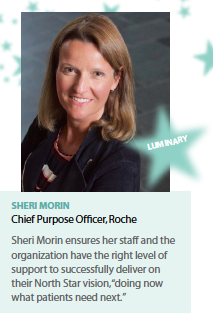 Sheri Morin
Sheri Morin
Sparking Change
It’s a huge honor to be named an HBA Luminary. For Sheri Morin, on one hand it shows that her impact on the organization is recognized, on the other she sees it as a responsibility to contribute more to inspire change throughout the company.
Sheri is chief purpose officer and general manager in the Netherlands for Roche, where she has been instrumental in the transformation of the business. She describes her job as one of servant leadership — ensuring the organization and its employees are empowered and have the right level of support and the right networks to successfully deliver for the patient. The best part of her job, Sheri says, is being the spark to help others figure out how to take a leap and put their ideas into practice.
Inspiration comes from many different sources, and Sheri goes outside of the business and the industry to engage with others to seek new ways of working. She advises others — whether starting out or mid-career — to be curious and seek new ways to stretch oneself outside of their comfort zone.
“I learned early in my career that if I was in a rut or not feeling a sense of purpose to find ways to address change, through mentors or changing the scope of my work," she says. “I’ve always been a strong believer in not settling."
Sheri’s purpose is clearly to have an impact, while helping others succeed to levels they may not have thought possible.
In her office, she keeps a photo of a group of healthcare workers in Tanzania taken when she led a group from Roche to enable the local Tanzanian team to improve cancer care in their region, to remind herself of the change that one person can make. (PV)
~~~~~~~~~~~~~~~~~~~~~~~~~
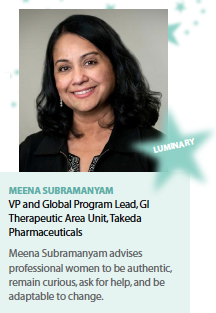 Meena Subramanyam
Meena Subramanyam
Focused on Patient Needs
In her role as VP and global program lead, GI therapeutic area unit at Takeda Pharmaceuticals, Meena Subramanyam pushes her team to test past assumptions based on evolving scientific and technical data, and urges critical scientific thinking to eschew preconceived notions. “I encourage a culture where people feel empowered to voice diverse opinions and take informed risks," she says.
Having been part of previous teams that have brought eight medicines to market, a key part of Meena’s current role is helping Takeda successfully manage through not only the regulatory process but substantiate the value of medicine to patients, physicians, and payers. “AI-driven digital solutions and wearable devices will play a key role in demonstrating the value of scientific innovation to patient benefit, and in improving preventive care through increased patient engagement," she says.
With an eye on the future, she says her job allows her to develop unique strategies to advance Takeda’s GI therapeutic assets and work with a multifunctional team to translate those strategies into clinical practice. “We want to be transformational and create better medicines for a brighter future," she says. “We interact with patients and caregivers to understand their issues from early symptoms to disease diagnosis and then develop therapeutic strategies to make a meaningful difference to patients."
Meena is not only a mentor to those she leads but to high school and college students embarking on STEM careers. “I’m also a board member of Women in the Enterprise of Science and Technology in Boston, which empowers women in science to achieve their full potential," she says. “I see mentoring as part of my responsibility, having been in this industry for more than 20 years I have the privilege of knowing many people. I like to help people find career opportunities and build their professional network."
The recognition from Takeda as an HBA Luminary, Meena says, is gratifying while also creating a deep sense of responsibility to continue to model good leadership behaviors and help others advance their careers. One key piece of advice to fellow female professionals she offers is to focus on strengths rather than weaknesses. (PV)
~~~~~~~~~~~~~~~~~~~~~~~~~
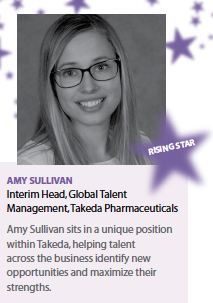 Amy Sullivan
Amy Sullivan
Reaching Across Borders
Amy Sullivan encourages her team members to expand their networks and build new connections as they advance in their careers. It’s an approach she has taken in her own career, and it’s embedded in her role as Takeda’s interim head of global talent management.
As part of Amy’s remit, her team manages early career programs, coaching people joining Takeda straight from college, and rotating them through three-year programs to gain different experiences. “To help people transition from campus to corporate life, we pair each participant with an on-boarding buddy who serves as a peer-mentor, as well as with someone outside of their line function," she says.
Amy also led the implementation of Takeda’s enterprise Talent Pipeline Review and monthly HR Leadership Team Talent Talks, which have resulted in targeted development opportunities for many employees and improved the organization’s bench strength.
Beyond Takeda, Amy continues to mentor other professionals looking to progress in their careers. She serves as a LinkedIn volunteer, for example, and is currently helping a young administrative assistant looking for ways to advance. A key piece of advice she offers is to seek opportunities to gain required skills and experiences before going after the next promotion. “If you want to manage people, for instance, find someone to mentor, or offer to train and support a new hire," she says. “We have many employee resource groups, including our Women at Takeda group, which provide terrific opportunities for people to gain leadership experience.
“We build our leadership programs with globalization in mind, offering cross-cultural training, coaching, and rotation experiences that help our people work across borders and leverage diverse talents," she continues.
Amy’s passion for helping others reach their full potential has been a constant throughout her career. She has demonstrated it time and again through her personal commitments and her leadership of programs Takeda relies on to identify, develop, and retain top talent.(PV)
~~~~~~~~~~~~~~~~~~~~~~~~~
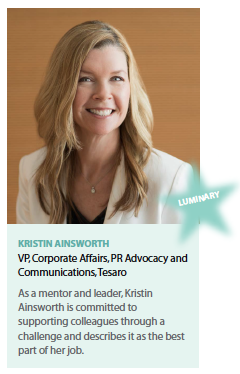 Kristin Ainsworth
Kristin Ainsworth
Guiding Women to Opportunities
There’s no bigger critic of your work than yourself, says Kristin Ainsworth, VP of corporate affairs, PR advocacy and communications, at Tesaro. And she knows this is particularly true with women, where voices of self-doubt can be powerful.
“I have found that if your inner critic is telling you something might be possible, then you’ve already leapt over the biggest hurdle," she says. “If we all took the opportunity to be risk takers and didn’t let doubt get in the way, imagine where we could be."
As a mentor and a leader, Kristin is committed to supporting colleagues through every challenge. In fact, she describes this as the best part of her job.
“I mentor a number of people in Tesaro and we meet regularly, usually outside the office, to talk about any number of topics — from professional, to personal, to community," she says.
Being available and Present
Kristin is honored and humbled to have been named an HBA Luminary by her colleagues and peers. For her, being a role model is about being available and present with the people on her team and being authentic in everything she does.
She describes herself as a situational leader, basing her management style on the principles of understanding who the individuals are on the team, meeting them where they are in their career journey, and understanding how much direction and support they need to achieve their goals.
“Just recently, I met with a teammate who had talked herself out of raising her hand for an opportunity in the company because she just didn’t feel she was ready for it," Kristin says.
“And as we sat and talked about all the reasons why that was and wasn’t the case, I watched her gain confidence in herself, and come to the understanding that getting an opportunity to do what she didn’t think was possible, was possible, that was really neat.
Mentorship has been integral to Kristin’s career — both giving and receiving. While she didn’t have formal mentors, there were always individuals who she would go to with questions about her career as well as business issues.
“All I know is to be myself and to be available and to be present with the individuals on my team, individuals throughout the organization, and with individuals throughout the industry," she says. “I think there’s also a big lesson in being authentic. We shouldn’t feel pressure to be someone we’re not. My advice is just be yourself and folks will seek you out for advice and guidance."
The personal is important to Kristin. Indeed, the item in the office she most values is a letter from her 7-year-old daughter written while she was away on a business trip. It says simply: “Mommy I’m sorry you had to be gone for a day, I missed you so much." Kristin hangs that letter in her office as a reminder to put family first and be very thoughtful before booking that airplane or train ticket.
“Because time is so precious, I always weigh if attending a meeting will add value or would my time be better spent at home with my kids," she says.
Giving Back and Paying it Forward
Today, Kristin more than gives back to the industry — both within Tesaro and as an HBA member.
As a leader in PR advocacy and communications, Kristin has been at the forefront of big changes in patient outreach. Because pharma is so heavily regulated it has been slow to embrace social media. But that has changed.
“We’re doing a better job recognizing the good that can come from setting up appropriate channels to organize communities of patients," she says. “For example, our company is heavily invested in helping women with advanced ovarian cancer have better conversations with their healthcare professionals about the disease treatment options, side effects of treatment, and living with advanced ovarian cancer in general. It’s a wonderful opportunity to help these women connect with others living with this disease."
It’s all part of a big trend, in which pharma is finding new ways to reach more people in the healthcare space, Kristin says. “It’s about meeting people where they are and in ways that are accessible 24/7 to give people the appropriate information to make good healthcare decisions."
Blazing A New Trail
Kristin and her company have deep connections to the HBA in the Boston region. In 2018, Kristin was nominated to be a member of the first Executive Exchange (https://www.hbanet.org/executive-exchange) program, which brings together senior-level members in the industry to give them an opportunity to explore new leadership opportunities. A key objective is to help women at the C-suite, VP, and executive VP levels gain new insights and address problems related to gender parity, diversity, and inclusion.
“The program is now in its second year, and it’s been a tremendous success," she says. “I was honored not only to be nominated for the program but to participate in the inaugural year." (PV)
~~~~~~~~~~~~~~~~~~~~~~~~~
Trend Tracking
The HBA’s 2019 Rising Stars and Luminaries provide their insights on the trends they are tracking that they believe will impact the industry in the coming years.
Artificial Intelligence
Apoorva Aggarwal — Rising Star
Principal, ZS Associates
AI in pharma is exploding as care and decision making begin to shift from a human model to a human-machine collaboration model.
Lily Dobberteen — Rising Star
Project Operations Specialist, AiCure
The trend that will most impact healthcare is personalized medicine, the use of advances in genomic analysis, and artificial intelligence to inform individualized care.
Tara Fitzgerald — Luminary
President, Clinical Development Services,
Syneos Health
We have, and will continue to see, an increase in AI research, including machine learning and manual task automation. As the industry responds to get drugs to market faster, we will need to embrace change when it comes to clinical trial execution.
Brenda McGuirk Fix — Luminary
Senior Marketing Manager, U.S. Health and Life Sciences, Microsoft
AI, when used ethically, securely, and without bias, can solve business problems, speed drug discovery, personalize patient care, and unlock new diagnoses and treatments.
Natalia Kotchie — Rising Star
VP, R&D Applied Data Science Center, IQVIA
Where AI enhances human decision-making, augmented intelligence will transform drug development and overcome long-standing challenges. However commitment to change is required to realize the benefits.
Charmain Piotrowsky — Rising Star
Regional Business Director, NYC, Novo Nordisk
I believe that AI and the utilization of digital technology will have the greatest impact on how healthcare providers treat, patients self-manage, and insurers reimburse in the next few years.
Meena Subramanyam, Ph.D. — Luminary
VP and Global Program Leader, Takeda Pharmaceuticals
Real-world evidence generated by wearable devices and other AI-driven digital solutions will have a major impact on the future of healthcare and will be critical not only to translate the value of scientific innovation to patient benefit, but also to improve preventive care through increased patient engagement.
Connectivity
Shannon Gath — Rising Star
VP, Head of Technology, AMAG Pharmaceuticals
Robust networked healthcare ecosystems that will connect patients, clinicians, caregivers, and payers more directly will lead to opportunities to deliver more affordable and convenient quality care.
Costs
Divya Annamraju — Luminary
Deputy Director, Strategy
Medical Devices Product Supply, Bayer U.S.
With increasing income inequality and rising healthcare costs, finding ways to make quality healthcare accessible in a fiscally sustainable manner is more important than ever. The healthcare industry has the potential to develop breakthrough solutions across the full healthcare delivery continuum, which will ultimately benefit patients and communities alike for years to come.
Leann Pezdirtz — Luminary
Head, Field Based Medicine, Boehringer Ingelheim
The vertical integration of healthcare from payer to PBM to provider will continue to be a trend.
Data Intelligence
Ellie He — Rising Star
Director, Head of Biometrics, Imbrium Therapeutics, a subsidiary of Purdue Pharma
Hiding within those mountains of data are answers and knowledge that could change the lives of patients, or change the world. Organizations that are passionate and committed to applying data intelligence to extract new and valuable insights will be the leaders who create the future value that others miss.
Jennifer McGee — Luminary
VP and Chief Compliance Officer,
Otsuka America Pharmaceutical
Increasing proliferation of data allows for better-educated consumers and enables providers to use AI in diagnosis and treatment. This data is a double-edged sword, with significant privacy and ethical considerations to safeguard its use.
Iramis Ralat — Rising Star
Director, OSD Manufacturing Operations, Bristol-Myers Squibb
The broader use of real-world data will lead to a deeper understanding of the impact of the different therapies beyond the clinical trials to influence the market access of medicines in the future.
Drug Pricing
Andrea Johnston — Luminary
President, W2O pure, W2O Group
As clinical development continues its rapid pace of innovation, payer and pricing models must evolve to enable potentially curative therapies to be delivered to patients.
Madhuri Shah — Rising Star
Brand Lead, Rexulti, Lundbeck
The trend that I believe will have the biggest impact is increased drug pricing. I don’t think the industry will be able to sustain the magnitude of yearly price increases, however, not taking the price increases may have a negative impact on innovation and investment in R&D. It will be critical to find the right balance.
Health Outcomes
Elizabeth Davies — Rising Star
Senior Director, Brand Payer Marketing, U.S. Pharmaceuticals, GSK
Recent payer-PBM mergers and increasing real-time data integration will allow for a more holistic examination across pharmacy and medical costs and associated health outcomes.
Kelly Hornsby-Clawson — Rising Star
Director, Customer Support, Roche Diabetes Care
As Americans gain more interest and control over their health, pressure will continue to increase on the costs associated with healthcare and the resulting health outcomes.
Liz Paulson — Luminary
Strategic Account Executive, LexisNexis Risk Solutions
Social determinants of health provide a complete picture of patients and the nonmedical factors influencing their health that if addressed proactively can improve outcomes.
Patient-Centricity and Personalized Health
Erin Byrczek — Luminary
VP, U.S. Brands, Pfizer
In a fragmented and increasingly digitized healthcare landscape, changing patients’ lives by empowering them with personalized, need-meeting resources will have the biggest impact.
Michele Irwin Cunningham — Rising Star
VP, Commercial Operations, Strongbridge Biopharma
The voice of the patient continues to be elevated in healthcare. This is especially true in rare diseases, where connecting patients to share their experiences, and amplifying the patient voice for the physician audience, can foster better understanding of the unique journeys and challenges faced.
Kari Delahunty — Rising Star
Senior VP, Corporate Strategy, Syneos Health
One of the biggest challenges facing the healthcare industry is the consumerization of healthcare. We must improve customer (e.g., HCPs, physician, GP) engagement and patient satisfaction by adopting a consumer-centric model that drives value for all stakeholders, specifically the patient.
Allyson Funk — Rising Star
Head of U.S. Communications and Public Affairs, UCB
There has long been recognition that healthcare is not one-size-fits-all, but we are seeing more and more approaches to deliver healthcare that meets the needs of individuals. Whether it’s how we innovate to find solutions or leveraging technology and learning to serve people the way they need to be served, the future is exciting.
Kathi Henson — Luminary
President, Patient Services, Eversana
Patient-centric innovations in education and technology will be important as the payer landscape drives focus on demonstrating improved health outcomes.
Kaye Kittredge — Rising Star
Project/Program Manager, Ability Network, an Inovalon company
Patient consumerism is a big trend. At its core, healthcare needs to make people’s lives better through access and price transparency for patients, data and ease-of-use for providers, and outcome-based accountability.
Jennifer Korngut — Rising Star
Account Supervisor, Havas Health +
Patient engagement through automation is a big trend. Just this week, we saw Amazon launch HIPAA-compliant healthcare skills for Alexa.
Sheri Morin — Luminary
Chief Purpose Officer/General Manager, Roche
We need to increase our efforts around personalized healthcare, truly delivering the right medicine and solutions to the right patients at the right time.
Catherine Owen — Luminary
President, Janssen Immunology at Johnson & Johnson
Patients’ experience, and their ability to make a more informed choice in their own healthcare journey, continues to be a trend that we need to embrace further.
LeAnne Walstra — Rising Star
Group VP, Client Services, The Lockwood Group
On-demand patient care bringing medical professionals to patients wherever they are, whenever they need it, through online and telemedicine services, will radically transform healthcare.
Jenny Woodward — Rising Star
VP, Group Art Supervisor, TBWA\WorldHealth
People have been exposed to digital innovation in healthcare for several years now. They understand how to best use these advances for their health and well-being.
Michele Wylie — Rising Star
Associate Director – Market Access Operations, Novo Nordisk
The healthcare industry will continue to evolve to a patient-centric design perspective model and find ways to partner more often within the industry to bring expertise and creativity together within business models to readily create more solutions for the patient.
Preventive Care
Kristin Ainsworth — Luminary
VP, Corporate Affairs, PR Advocacy and Communications, Tesaro
We’re finding ways to reach more people in the healthcare space outside of traditional ways, meaning a rep to a doctor. It’s about meeting people where they are and meeting them in ways that are accessible 24/7, whether that’s online, digital platforms, radio, or TV. It’s about putting our information appropriately in the hands of people so they can make good healthcare decisions in ways that are not just so traditional anymore.
Bridget Mabey — Rising Star
Associate Creative Director, Ogilvy Health
Consumers are becoming more educated about their own wellness and steps they can take to prevent chronic illness. This is a great opportunity for investment in new technologies that help keep people healthy, both physically and mentally.
Sarah Mooiweer — Rising Star
Account Supervisor, TBWA\WorldHealth
People are proactively seeking information about their health to inform preventive treatments. What can we build on between genetic testing and customized vitamin packs to green juice and spinning?
Policy and Regulations
Alexandra Bauer — Rising Star
Account Director, Calcium USA
Healthcare policy makers and payers are increasingly dictating which drugs HCPs can prescribe, which limits HCP’s prescribing power.
Kathy Schaefer — Luminary
Senior VP Finance, Corporate Controller, Mallinckrodt Pharmaceuticals
There are many things going on in the government affecting our business, whether it’s regulations around opioids, or price discussions for branded drugs. We have to be flexible and know how to navigate through these challenges.
Ami Simunovich — Rising Star
Chief Regulatory Counsel, BD
The changing global laws, regulation, and enforcement on devices will have the biggest impact on healthcare. Compliance enforcement will shape how we get affordable disruptive technologies to global markets.
Elizabeth Woody — Luminary
VP, Public Affairs, BD
When I think about policy makers I think about that term very broadly to include legislators, administration officials, provider groups, professional societies, patient groups, any entity that’s setting policy, a guideline or a regulation or legislation. They all have an impact on our ability to be successful.
Scientific Innovation
Róisín Armstrong, Ph.S. — Luminary
VP, Soliris Medicine Team Leader, Alexion
Scientific breakthroughs will deliver increasingly innovative, life-changing rare-disease medicines. It’s the shared responsibility of all stakeholders to work together so patients benefit from these breakthroughs.
Tiffany Chen, Ph.D. — Rising Star
Directory, Discovery, Rubius Therapeutics
Cell and gene therapy are rapidly emerging as potentially curative treatments for the most challenging diseases. We are on the cusp of a medical revolution.
Nicole Crawford — Rising Star
Executive Business Director, Solid Tumor Northeast Region, Novartis Oncology
We are fortunate enough to be at a precipice of science with major advancements that offer patients a potential cure rather than chronic treatment and this will undoubtedly disrupt the healthcare industry.
Deepa Desai, M.D. — Luminary
VP, Quality Assurance, IQVIA
We are in an interesting time of transformation: AI and machine learning vs. physicians and human touch. Consumers ask for seamless, just-in-time, accurate information to make accurate decisions via DIY (mobile) technology vs. clinical. Thus for me, the No. 1 trend would be scientific innovation, from genomics studies to assess risk and prevent disease proactively to exploring virtual surgeries via 3D bioprinting technology or AI-based devices for accurate diagnosis. Using blockchain and data science, algorithms can be created to test chemical and biological interactions, which are more safe and accurate. This can help pharmaceutical R&D to bring effective medicines to market faster and cheaper.
Elena Herrero — Rising Star
Group Art Supervisor, Evoke Giant
During the past few years, scientific, medical, and technological advances have ushered in a revolutionary new era of immunotherapy. It is my hope that tailoring immunotherapy to the specific microenvironment of each patient’s tumor will become the new standard of care for cancer treatment. This, combined with computer-aided prediction using AI, holds great promise for shaping the future of healthcare.
Janna Hutz — Rising Star
Senior Director and Head, Data Science & Scientific Infrastructure, Eisai
Working with so many talented data scientists, I think the growth of human biology data and the enthusiasm around it will lead to meaningful impact.
Vera Imper, Ph.D. — Luminary
VP and Head of Business Development, Roche Molecular Solutions
I believe precision diagnostics will transform patient care by delivering high-value clinical insights and optimizing medical decision-making.
Danielle King — Rising Star
Account Service, Fingerpaint
With the rise of 23&Me and therapies such as CAR-T, patients will demand, and for the first time be able to receive, truly personalized treatment at the genetic level across their care team.
Kelly Lenahan — Rising Star
Manager, Scientific and Health Policy Initiatives, ISPOR—The Professional Society for Health Economics and Outcomes Research
I believe that more personalized gene, CAR-T, and curative therapies will have the most impact on healthcare in the future. These are treatments that are important to patients and improving healthcare, yet play a huge burden on the budgets of healthcare systems and payers.
Candice Lenkowsky — Luminary
Head, US Immunoscience Sales, Bristol-Myers Squibb
Precision medicine has changed treatment approach in cancer and is rapidly expanding to other areas such as rheumatoid arthritis and multiple sclerosis.
Stephanie Tanck — Rising Star
Associate Product Manager, Ortho Clinical Diagnostics
Agile diagnostic solutions are needed to better address global clinical needs driven by changing lifestyles, ranging from infectious disease and diabetes in emerging markets, to fertility and drugs of abuse in developed markets.
Daniela Vernille — Rising Star
Director of Logistics Solutions and Compliance, Pfizer
Access to innovative oncology medicines in emerging markets is a big problem and we need to remain committed to work collaboratively to ensure patients have access to life-saving medicines.
Talent Management
Tracey Morrison — Rising Star
Director Human Resources, UCB
Finding the right talent/employee who has a multidisciplinary skillset that compliments the complexity of the healthcare industry is a growing trend. Why? Because the evolution and transformation of the industry mindset is shifting from tactical to strategic ways of engagement. Talent is more diverse and agile. Our challenge will be to find this talent and even more challenging will be how we retain this talent given the need for the more multidimensional skill set.
Technology and Advanced Analytics
Cori McKeever Ashford — Rising Star
Executive VP, Healthcare Practice Lead, Central Geo, Weber Shandwick
Technology will continue to transform healthcare, but only as far as our ability to articulate its human impact on patients, providers, and payers.
Domenica Askeland — Rising Star
VP, Global HR Operations, Pfizer
Leveraging technology and amplifying digital efforts will power us to discover and identify preventive treatments faster for our patients and improve our overall productivity.
Sarah Bast — Rising Star
Group VP, Media, Publicis Health
Over the last decade, technology and mass digitization have transformed possibilities for healthcare marketing across the board, with point of care emerging as one of the most intriguing and exciting channels. Marketers must embrace a new strategy for targeting in the POC channel — one that uses diverse datasets and algorithmic learning to define target audiences based on a much broader set of criteria.
Terentia Browne — Rising Star
Engineering Manager – Consumer Sweden, Johnson & Johnson
We are seeing more examples of how Industry 4.0 is shaping the decisions we as leaders are taking when it comes to investments in technology.
Denise Chambley, Pharm.D. — Rising Star
VP, North America Medical Solutions, PHS Health Solutions
One of the trends I see is perfecting the right balance between technology and superb live interactions with our patients so that we don’t lose the human behind a diagnosis.
Melissa Falcone — Rising Star
VP, Patient Services and Reimbursement, Mallinckrodt Pharmaceuticals
I think about how mobile apps and telemedicine and wearables impact our ability to help patients manage their disease. At the same time this gives us a huge amount of data that can be collected and analyzed and put into things like AI to help us further advance our knowledge of disease areas, evolve our technology, and advance our products to serve their unmet needs.
Beatriz Faro — Luminary
Regional President IDM IM, Pfizer
Predictive analytics and big data will change everything from R&D to manufacturing to commercialization of drugs, allowing for more personalized treatments.
Adriana Fernandez — Rising Star
Senior IT Director, Manufacturing and Quality, Eli Lilly
The Internet of Things, data, and the ability to connect devices to patients and healthcare providers will provide the ability to have highly personalized consumer-centric health. In addition, the power of information exchange will allow for the continuing discovery of new solutions for patients.
Jennifer Foley — Rising Star
Global Head – Business Insights & Analytics, Product Development Clinical Operations, Genentech
Our increasing ability to unlock big data through advanced analytics is significantly evolving healthcare — from enabling us to more readily predict disease and intervene earlier for better patient outcomes to speeding up and reducing risk in R&D to creating greater efficiencies in how care is delivered.
Tiffany Gallagher — Rising Star
Partner, PwC
Technology will continue to move patients to the center and improve the connectivity and engagement across the healthcare ecosystem.
Ponda Motsepe-Ditshego, M.D. — Rising Star
Executive Medical Director, Amgen Canada
Novel bioscience technologies assist researchers to target specific disease pathways and develop personalized therapies, using machine learning and AI, which allows for early disease detection and enhance patient-centricity.
Stephanie Otis — Rising Star
Senior Director, Commercial Operations, Ferring Pharmaceuticals
Innovation is intensifying in all areas across the healthcare continuum. The future of the industry is being transformed by the development of digital and therapeutic innovation. We are witnessing disruption in digital technologies and advancements in therapies that will require enhanced coordination and integration across functions and channels.
Catharina (Candy) Lurken — Luminary
Principal, Deloitte Consulting LLP
Digital health transformation, which is being driven by strong market signals related to data as the new healthcare currency, evolving patient expectations, and standards supporting data exchange, show a path for transformation toward driving outcomes through a more connected patient ecosystem.
Cathy Skala — Luminary
VP, Business Transformation Office, Baxter International
I anticipate breakthroughs in managing patients’ health through data analytics. Just imagine being able to develop treatment options with science, data, and artificial intelligence combined.
Heather Zigmund — Rising Star
Senior Director, Head of Clinical Services, AstraZeneca Pharmaceuticals
New technology developments will give us the tools to unleash the power of the human immune system, ultimately changing the way we approach healthcare and optimizing patient outcomes.
Transparency
Judy Sewards — Rising Star
VP, Head of Clinical Trial Experience, Pfizer
Transparency is the foundation of trust. Our customers, and importantly our colleagues who are driving future innovation, expect open, accountable, and purpose-driven actions and communications.
Angela Tenuta — Luminary
Executive VP, Intouch Group
Regulated transparency and rapid health-tech advancement will realign healthcare around the consumer. More specifically: consumer health activism — buckle up.
Audrey Wu — Rising Star
VP, ThinkGen
We must deliver on changing expectations in value creation and transparency.
~~~~~~~~~~~~~~~~~~~~~~~~~
RISING STARS
Apoorva Aggarwal
Principal, ZS Associates
Leadership Style: Authenticity
I’ve always believed that being yourself and being authentic are important factors to success, as they sit at the intersection of what you are passionate about and what you are good at.
Kimberly Anders
VP, Acute Sales, Cardinal Health
Cori McKeever Ashford
Executive VP, Healthcare Practice Lead, Central Geo, Weber Shandwick
Leadership Style: Integrative
The best ideas can come from junior to senior colleagues and across different disciplines. I approach my teams with the mindset that we’ll accomplish our greatest success when we seamlessly partner and collaborate together.
Domenica Askeland
VP, Global HR Operations, Pfizer Inc.
Leadership Style: Transparent and Empathetic
Transparency is the key to providing my team with the information they need to be effective in their roles and for me to earn their respect and trust. Empathy allows me to understand my team and provides me with flexibility to respond to critical business issues faster.
Carole Augustine
Senior Director Business Excellence, Digital Medicine, Otsuka America Pharmaceutical Inc.
Elizabeth Balthrop
DVP, Cardiometabolic and Informatics, Rapid Diagnostics, Abbott
Sarah BAst
Group VP, Media, Publicis Health
Leadership Style: Empowering
I am the type of leader who empowers my team to take action by giving them the tools and the confidence they need to reach new heights.
Alexandra Bauer
Account Director, Calcium USA
Leadership Style: Emotional Intelligence
Self-awareness enables me to appreciate how my words and actions impact others, which fosters positive and productive relationships with my colleagues and clients.
Amanda Baumann
Senior Director R&D Robotics, Stryker
Kathryn Boyd
Business Strategy Senior Manager, Accenture
Terentia Browne
Engineering Manager – Consumer Sweden, Johnson & Johnson
Leadership Style: Purpose-driven
Being purpose driven means that I can connect with my team and motivate them to find purpose and fulfillment in their work. Seeing the value you add to people and the organization is energizing and contagious.
Denise Chambley, Pharm.D.
VP, North America Medical Solutions, PHS Health Solutions
Leadership Style: Positivity
Being positive is a choice. I choose it because looking at the world through an optimistic lens enables me to view life, work, challenges, and people in a more open way. This enables people to feel accepted, be themselves, and be inspired to do their best work.
Tiffany Chen, Ph.D.
Directory, Discovery, Rubius Therapeutics
Leadership Style: Facilitative
To achieve highest-quality scientific results, I aim to build a culture where individuals and teams are empowered to make decisions in a fast-paced, collaborative environment.
Traci Clarke
VP, Client Services, The Scienomics Group, An Omnicom Company
Nicole Crawford
Executive Business Director, Solid Tumor Northeast Region, Novartis Oncology
Leadership Style: Unboss
I provide clarity on objectives for my team and create space and flexibility for innovation on the how to achieve. My goal is to serve the team by removing barriers while ensuring accountability. It is also important that we have some fun along the way.
Michele Irwin Cunningham
VP, Commercial Operations, Strongbridge Biopharma
Leadership Style: Collaborative
Collaborative leadership based on authentic relationships is essential to gain alignment and to ensure various perspectives are considered when making decisions that impact the business.
Elizabeth Davies
Senior Director, Brand Payer Marketing, U.S. Pharmaceuticals, GSK
Leadership Style: Emotional Intelligence
Continual focus on self-awareness and self-regulation has allowed me to build relationships in a highly matrixed organization, make objective decisions in times of high uncertainty, and help teams adapt quickly to environmental changes.
Kari Delahunty
Senior VP, Corporate Strategy, Syneos Health
Leadership Style: Collaboration and Execution
I believe there is a true responsibility when managing teams, directly or indirectly. I strive to create an environment where trust and transparency are part of the culture in order that everyone can successfully contribute. We all have something to contribute, and as a leader, it is my responsibility to create an environment and culture where people feel engaged to be part of a successful solution.
Lily Dobberteen
Project Operations Specialist, AiCure
Leadership Style: Confidence and Humility
These two qualities mean having the humility to seek more knowledge with the confidence to teach it back.
Priya Emmanuel
Managing Director, KPMG
Melissa Falcone
VP, Patient Services and Reimbursement, Mallinckrodt Pharmaceuticals
Leadership Style: Shared Vision
If you don’t have a vision for what the future should look like and a vision that is built with all the parties involved you’re not going anywhere; then once we have that alignment, I believe that my team is empowered to do what they do best.
Adriana Fernandez
Senior IT Director, Manufacturing and Quality, Eli Lilly
Leadership Style: Action-Oriented and Passion
I like to see results and get things done. I think that to be able to lead I need to demonstrate to the people who surround me — direct reports, peers, senior managers — that I am able to translate strategies into actions and get results. I also have a passion for the people who work with customers and the patients who we serve.
Jennifer Foley
Global Head – Business Insights & Analytics (BIA), Product Development Clinical Operations, Genentech
Leadership Style: Real
I recognize that I’m far from perfect, but know that I’m doing the best I can on any given day for my colleagues and the patients we serve. This allows me to demand the best from others, but the grace to be realistic and appreciate that when we struggle, we’re learning.
Allyson Funk
Head of U.S. Communications and Public Affairs, UCB
Leadership Style: Curious and Assertive
From approaching challenges with a learner’s mindset, asking questions, and understanding the objective, my style is to lead with curiosity. When it comes to action, I am assertive; being a leader often takes courage and the willingness to make decisions. Sometimes we try and fail, but there is always learning in those experiences and they help us to keep moving forward.
Tiffany Gallagher
Partner, PwC
Leadership Style: Humility, Diplomacy, Open-Mindedness
You can learn from all those around you if you listen, collaborate, and are willing to change.
Julie Garner
Head of US Government Affairs, AstraZeneca Pharmaceuticals
Shannon Gath
VP, Head of Technology, AMAG Pharmaceuticals
Leadership Style: Empowerment
I’m responsible for coalescing the intelligence of my team to maximize our collective talents. Through empowerment and supporting their decisions, we contribute to the organization and play a role in the advancement of the company.
Stacey Gibbons
VP, Meeting Planning – Speaker Bureau Services, Health & Wellness Partners
Ellie He
Director, Head of Biometrics, Imbrium Therapeutics, a subsidiary of Purdue Pharma
Leadership Style: Bringing out the Best in People
Good leaders are able to create a supportive environment that will bring out the best in people, encourage all the members to develop their skills and creativity, and inspire the teams to work together toward the common goal.
Elena Herrero
Group Art Supervisor
Evoke Giant
Leadership Style: Resourcefulness and Passion
With so much happening at our workplaces and in our industry today, having the ability to take on change and adapt to what’s happening around us with passion while keeping true engagement top of mind is essential to achieving success in our ever-changing business environment.
Kelly Hornsby-Clawson
Director, Customer Support, Roche Diabetes Care
Leadership Style: Relator
I am driven to help people link together ideas and resources, solve problems, and simplify complex situations.
Ann Howell
Senior Director, U.S. Regulatory Affairs – GDP, Shionogi
Janna Hutz
Senior Director and Head, Data Science & Scientific Infrastructure, Eisai
Leadership Style: Understanding
Constantly striving to better understand and communicate our science and my team’s needs is my highest priority.
Danielle King
Account Service, Fingerpaint
Leadership Style: Pragmatic
One of the biggest ways I believe I can support my team is to be a sound, logical voice that helps to break through the often frenzied environment of advertising.
Kaye Kittredge
Project/Program Manager, Ability Network, an Inovalon company
Leadership Style: Servant Leadership
Most often, I’m in the company of smart, dedicated professionals and the best thing I can offer is to help align everyone to a common goal and make room for their contributions.
Jennifer Korngut
Account Supervisor, Havas Health+
Leadership Style: Decisiveness
I have confidence in my ability to make quick decisions under pressure.
Natalia Kotchie
VP, R&D Applied Data Science Center, IQVIA
Leadership Style: Adaptability
In a rapidly evolving environment, being able to respond to change or make changes is key; this requires listening to others and really hearing what they are saying. I am constantly learning from my team and colleagues, and in order to do that I have found openness and flexibility invaluable.
Kelly Lenahan
Manager, Scientific and Health Policy Initiatives, ISPOR—The Professional Society for Health Economics and Outcomes Research
Leadership Style: Perseverance
No matter what is the set back, I always try to find a way to move forward, even in moments of the most chaos and despair. It has helped strengthen me and motivate me to do better.
Linda Louie
Executive Director, Accounting, Amgen
Bridget Mabey
Associate Creative Director, Ogilvy Health
Leadership Style: Empathetic
Nurturing relationships within our teams is key to success. When people feel appreciated and valued, amazing work will follow.
Mary Mallaney
Associate Director, Liso-Cel /CMC Lead, Celgene
Sarah Mooiweer
Account Supervisor
TBWA\WorldHealth
Leadership Style: Empowering
I work to give my teammates the tools and confidence to make decisions on their own. I think all challenges should lead to learnings and we should all face them with an open mind and without fear.
Tracey Morrison
Director Human Resources, UCB
Leadership Style: Authentic and Resilient
I’m authentic in that I am self-aware of my strengths and opportunities. I am a person of my word and I lead by example. I am also a resilient leader as I seek to provide direction through all situations. I use my energy to charge others to be great.
Shenetra Moses
Plant Manager, Baxter International
Ponda Motsepe-Ditshego, M.D.
Executive Medical Director,
Amgen Canada
Leadership Style: Respectful, Authentic, and Equality
My late father used to say, “you should be able to converse with the president of the country and similarly converse with the janitor in your building and treat them exactly the same." Mutual respect is important to me and so is how I make people feel. I also care about mentorship and developing people so they can reach their goals.
Gretchen Murphy
Associate Director, R&D Communications, Public Affairs, Alkermes
Stephanie Otis
Senior Director, Commercial Operations, Ferring Pharmaceuticals
Leadership Style: Resilient
With the fast pace of change, being resilient is critically important. At work and at home, I look at challenges as opportunities and adapt to situations where it is necessary to be agile and open to change. Remaining aware, flexible, and compassionate allows me to understand the obstacles, quickly adjust to changing circumstances, and assess ways I can improve and develop from each experience.
Kathleen Palladino
Director of Pharma Account Management, athenahealth
Charmain Piotrowsky
Regional Business Director, NYC
Novo Nordisk
Leadership Style: Authentic and Transparent
I believe in fostering honest relationships to build trust within my team, which leads to greater loyalty and empowerment.
Saileta Prabhu, Ph.D.
Senior Director, Development Sciences, Genentech
Leadership Style: People-Focused
I’m always trying to figure out what’s the next best thing for my people. It’s the same thing I do for my organization.
Kara Price, Ph.D.
Director, Pharmaceutical Sciences Operations, Merck
Amrita Rahmani
Senior Director, Corporate Strategy, Regeneron Pharmaceuticals
Iramis Ralat
Director, OSD Manufacturing Operations, Bristol-Myers Squibb
Leadership Style: Authentic and Empowering
I do step back and accept I don’t have all the answers. When strategies are not delivering, it’s time to change to win the game and for that you need to empower your team.
Judy Sewards
VP, Head of Clinical Trial Experience, Pfizer
Leadership Style: Customer-Obsessed
Patients are the reason why we all get up in the morning and do the work we do. Creating a culture and mindset where customer needs are our north star, inspiration, and barometer for decision-making, each and every day, not only is good business but feels good.
Rachel Sexton
Marketing Innovation & Strategy Director, Health, RB
Madhuri Shah
Brand Lead, Rexulti, Lundbeck
Leadership Style: Results-Driven
It is critical to drive results for the business, which in turn enables us to help more patients. Although I am results-driven, how we get to the results matters to me as well.
Thaisa Silvestre
Director, Sales, Brazil, West Pharmaceutical Services
Ami Simunovich
Chief Regulatory Counsel
BD
Leadership Style: Authentic
I lead with humility and as a servant leader.
Lauren Stein
Director, Clinical Marketing, Performance Health
Amy Sullivan
Head of Talent Management, Takeda Pharmaceuticals Inc.
Leadership Style: Coach and Connector
I have navigated through my own career journey by building up my internal network and external network as well, and I encourage my team to do the same.
Stephanie Tanck
Associate Product Manager, Ortho Clinical Diagnostics
Leadership Style: Connector
Being able to see hidden connections between people and across processes, enables me to connect others to drive synergies and expand value for the organization. It’s also fun to boot.
Erika Toro
Senior Director, Project and Program Management, Magellan Rx Management
Mary Tzortzis
Canada Country Head, Clinical Study Unit North America, Sanofi R&D, Sanofi U.S.
Kathleen Veit
VP, Global Investigations & Compliance Monitoring, Teva Pharmaceuticals
Daniela Vernille
Director of Logistics Solutions and Compliance, Pfizer
Leadership Style: Servant Leadership
It is never about me. It is always about how to help people succeed in life, realize their vision and fulfill their purpose. It is about helping to execute a vision larger than me that will ultimately affect the lives of many others.
LeAnne Walstra
Group VP, Client Services, The Lockwood Group
Leadership Style: Problem-Solver
When problems arise, which they often do, I can see through the clutter, identify a clear path, and lead effectively.
Katrina Weigold
VP, Global Partners, Medidata
Jenny Woodward
VP, Group Art Supervisor, TBWA\WorldHealth
Leadership Style: Committed
I truly value the input and talents of everyone I work with and strive to show them my dedication to our collective work.
Audrey Wu
VP, ThinkGen
Leadership Style: Passionate
My passion for what I do fuels my ability to bring my highest and best to the table and inspires others to do the same.
Michele Wylie
Associate Director – Market Access Operations, Novo Nordisk
Leadership Style: Honest and Integrity
It’s often trust that connects people successfully from one significant event in time to another. Building your reputation based on trust and nurturing it throughout your career is key.
Heather Zigmund, Pharm.D.
Senior Director, Head of Clinical Services, AstraZeneca Pharmaceuticals
Leadership Style: Connecter
The fast pace of scientific and technological advances requires leaders who are able to bridge specialized areas to accelerate holistic innovation within the industry. During the course of my career, I’ve been able to successfully find common threads across disparate areas to drive delivery amid ambiguity.
LUMINARIES
Kristin Ainsworth
VP, Corporate Affairs, PR Advocacy and Communications, Tesaro
Leadership Style: Situational
Years ago, I began to really understand the people on my teams as individuals, meeting them where they are, and understanding how much direction and support they need. Or in certain cases, I just need to there to be a good listener and that allows them to do their thing because they’re very experienced. Each day could be different.
Divya Annamraju
Deputy Director, Strategy, Medical Devices Product Supply, Bayer US
Leadership Style: Inclusive
Inclusive leaders foster a collaborative environment that harnesses the richness of diverse perspectives and approaches of all its team members toward developing innovative solutions. As customer needs and expectations evolve over time, companies with inclusive cultures will be better positioned to distinguish themselves as thought leaders.
Róisín Armstrong, Ph.D.
VP, Soliris Medicine Team Leader, Alexion
Leadership Style: Purpose-Driven
At Alexion, our purpose is to serve patients living with rare diseases, and it drives every conversation, meeting, and decision I make with my team. By keeping patients at the center of all we do, we are better able to develop and deliver the medicines they need.
Diana Brainard, M.D.
Senior VP, HIV and Emerging Viral Infections, Gilead Sciences
Erin Byrczek
VP, U.S. Brands, Pfizer
Leadership Style: Decisive, Innovation-Oriented, Empowering
I have a proven track record of motivating multidisciplinary teams and growing talent to over-deliver against commercial and financial goals, while evolving our business model to better serve customer needs.
Jessie Collins
Senior VP, General Counsel, athenahealth
Brenda Cooperstone,M.D.
Senior VP, Chief Development Officer, Rare Diseases, Pfizer
Deepa Desai, M.D.
VP, Quality Assurance, IQVIA
Leadership Style: Compassionate and Influencer
I enjoy working with employees to develop the confidence to believe in themselves, take ownership to build their careers, and surmount challenges to achieve desired results.
Beatriz Faro
Regional President IDM IM, Pfizer
Leadership Qualities: Authenticity, Integrity, Passion for Diversity
The decisions that I make both at a personal and professional level are driven by these values. I fully understand the value of diversity from a personal and business point of view and I am fully committed to developing diverse teams.
Tara Fitzgerald
President, Clinical Development Services, Syneos Health
Leadership Style: Persistence
Because passion never gives up.
Brenda McGuirk Fix
Senior Marketing Manager, U.S. Health and Life Sciences, Microsoft
Leadership Style: Collaborative and Communicative
I love building teams, working with disparate stakeholders, launching projects and learning which communication style works best. I listen and learn from people with different points of views and goals.
Amy Flood
Senior VP, Public Affairs, Gilead Sciences
Chelsea Glinski
Executive Director Reimbursement Strategy, Astellas Pharma US
Kristen Hege, M.D.
Corporate VP, Translational Development, Hematology/Oncology, Celgene
Denise Henry
Associate Partner, Director of Strategic Services & HealthWork, CDM New York
Kathi Henson
President, Patient Services,
Eversana
Leadership Style: Collaborative and Committed
It takes a team to deliver extraordinary results and to support the entire organization’s success.
Cristin Hubbard
Lifecycle Leader, Hemlibra, Roche
Leadership Style: Transparency and Authenticity
I’m a really big believer that we are all smart adults, we all have integrity, and we all want to do the right thing. By equipping people with information upon which they can make good decisions, they can best serve patients. When people walk away from a conversation with me or a meeting with me, my hope is that they walk away knowing exactly who I am and what I think and what they’re going to get in the future.
Vera Imper, Ph.D.
VP and Head of Business Development, Roche Molecular Solutions
Leadership Style: Inclusion
As a leader, I believe that inclusion drives business success. By practicing an open door policy, respecting each individual’s capabilities and welcoming diversity of thought, we create a richer, more valuable and inclusive environment.
Andrea Johnston
President, W2O pure, W2O Group
Leadership Style: Decisive
As a leader, it is often important to make decisions efficiently and with clarity. Data-driven, thoughtful decisions made with speed and transparency are essential in a business that moves as fast as marketing communications in the digital world.
Jackie Kent
Senior VP, Product, Medidata
Candice Lenkowsky
Head, U.S. Immunoscience Sales, Bristol-Myers Squibb
Leadership Style: People-First
People drive a team’s culture, and culture will trump strategy every time.
Debbie Leonetti
Senior VP, Global Service and Repair and Sales Operations, Integra LifeSciences
Catharina (Candy) Lurken
Principal, Deloitte Consulting
Leadership Style: Global Collaborator
Knowing who to connect with and energize across our member firms is important for creating an impact for our clients.
Abigail Mallon
Chief Compliance Officer and Senior VP, Innovation, VMS BioMarketing
Susanne Martz, M.D.
Senior VP Global Head Quality, GSK Vaccines, GlaxoSmithKline
Barbara McAleer
Senior VP Tissue Technology Operations, Integra LifeSciences
Jennifer McGee
VP and Chief Compliance Officer, Otsuka America Pharmaceutical
Leadership Style: Team Builder
I strive to find opportunities to blend people into teams to foster open dialogue and share wins and successes among the team.
Sheri Morin
Chief Purpose Officer/General Manager, Roche
Leadership Style: Catalyst
I am intensely curious to co-create the future, while empowering colleagues to reach new levels they may not have thought possible.
Stephanie Nilsen, Ph.D.
Senior Director, Operations, Thermo Fisher Scientific
Keira O’Brien
VP, Chief Operations Officer, Government Markets, Magellan Rx Management
Danielle Otte
VP, Business Development, Doximity
Catherine Owen
President, Janssen Immunology, Johnson & Johnson
Leadership Style: Authentic
People need to believe in your heart, before they follow your head.
Liz Paulson
Strategic Account Executive
LexisNexis Risk Solutions
Leadership Qualities: Collaboration, Passion, Focus
Kathleen Pearson
Senior Director – Oncology Market Research/NPP, Eli Lilly
Jane Petrino
Managing Director, RxMosaic, Marina Maher Communications
Leann Pezdirtz
Head, Field Based Medicine, Boehringer Ingelheim
Leadership Style:
Facilitative
The talent, passion, and productivity lie within the team; my goal as a leader is to facilitate harnessing it to achieve our objectives.
Annlea Rumfola
Senior VP, Medical Segment IT, Cardinal Health
Kathy Schaefer
Senior VP Finance, Corporate Controller, Mallinckrodt Pharmaceuticals
Leadership Style: Adaptable
All of my direct reports don’t need the same type of leadership. Some need more, some need less. As a leader, you have to get to know your people and then understand what their needs are.
Christy Siegel, Pharm.D.
Head of Immunology, Inflammatory Diseases and Transplant, Novartis Pharmaceuticals
Cathy Skala
VP, Business Transformation Office, Baxter International
Leadership Style: Believer
I am a believer in people, their potential, and their ability to change, challenge, and deliver outstanding accomplishments.
Meena Subramanyam, Ph.D.
VP and Global Program Leader, Takeda Pharmaceuticals
Leadership Style: Inspirational
I am inquisitive by nature and always ask open-ended questions to encourage critical scientific thinking and challenge preconceived notions. I empower my team to set a bold vision and motivate them to take calculated risks grounded in experiential knowledge as well as evolving scientific and technical advancements.
Janani Swamy
Head of Operational Excellence, Engineering, Learning & Development, Sanofi Industrial Affairs, Sanofi U.S.
Angela Tenuta
Executive VP, Intouch Group
Leadership Style: Empowering and Courageous
Tina Ventura
Senior VP, Investor Relations, Horizon Pharma
Elizabeth Woody
VP, Public Affairs, BD
Leadership Style: A Dealer in Hope
The way I try to lead the team and the way I am inspired is by people. People want to be part of something bigger than themselves and want to contribute to something that’s positive.
ing bigger than themselves and want to contribute to something that’s positive.

















